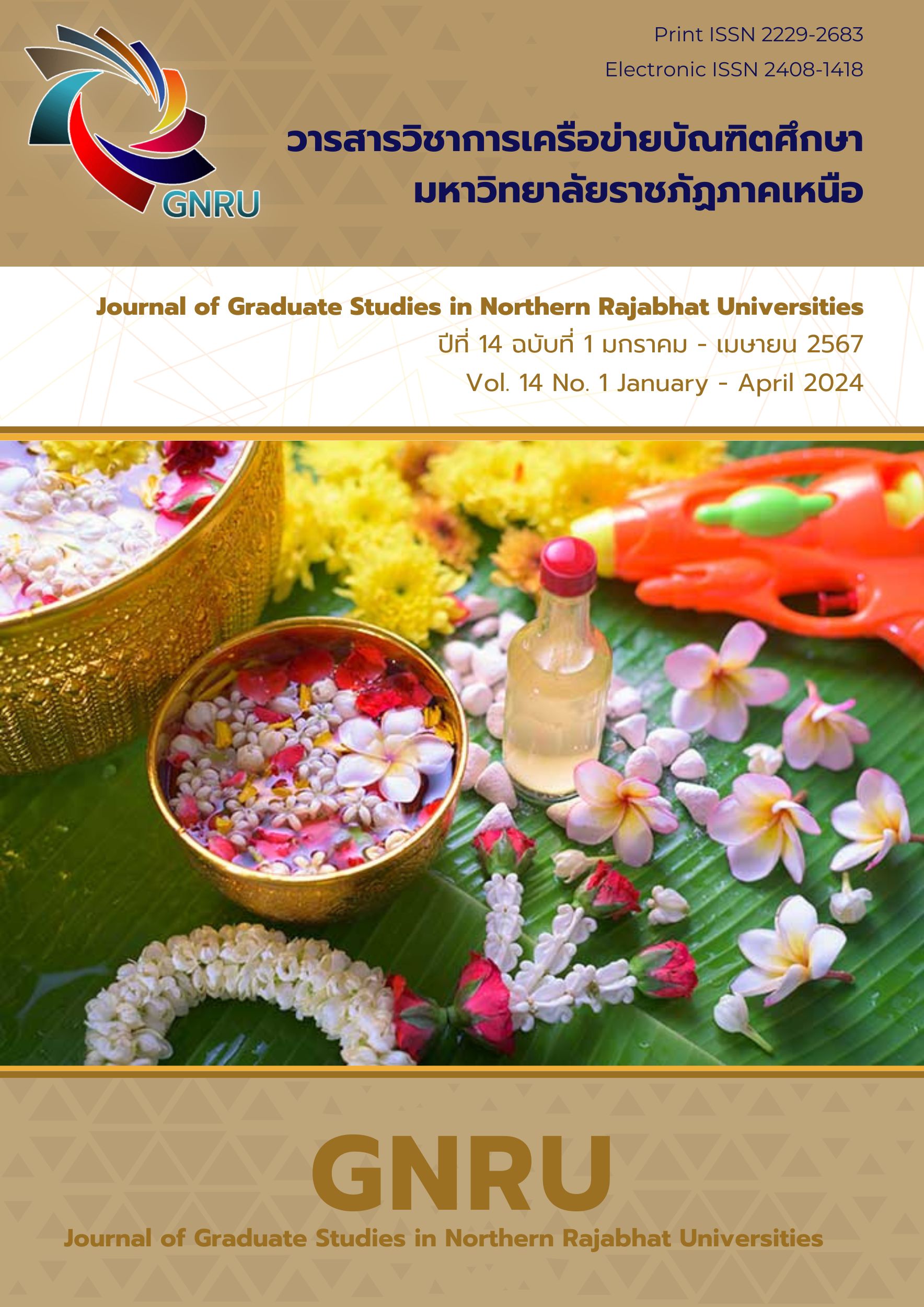6 THE DEVELOPMENT OF A TRAINING PROGRAM TO ENHANCE STUDENTS’ GRIT AT RAJABHAT LAMPANG UNIVERSITY
Main Article Content
Abstract
The objectives of this research were to study the characteristics of grit and ways to enhance students’ grit, develop a training program to enhance students’ grit, and examine the effects of using the training program. The participants were 30 undergraduate students of Lampang Rajabhat University, selected by voluntary selection. The instruments used in the research include interviews, a grit test, and a training program to enhance grit. Data were analyzed using basic statistics, including percentage, mean, standard deviation, and repeated measures ANOVA. The results showed that the grit of Lampang Rajabhat University students consisted of interest, deliberate practice, purpose, and hope. The guidelines for enhancing students’ grit included building self-awareness, enhancing necessary skills for learning, managing learning focusing on experience, learning from successful models, and empowering learning. In addition, the training program consisted of the development of training program purpose, creating a lesson plan, and an evaluation plan. The evaluation of the program showed that it was at a high level, and the students' grit after the experiment, and follow-up, was higher than that before the experiment. Also, there was a difference between the students' grit in terms of interest and hope with statistical significance at 0.05
Article Details
References
Bandura, A. (1997). Self-efficacy: The exercise of control. New York: W.H. Freeman.
Bandura, A. (1977). Social learning theory: A social cognitive theory. New Jersey: Prentice – Hall.
Best, J.W., & Kahn, J.V. (1989). Research in education (6th Edition). Englewoods Cliffs, N.J.: Prentice-Hall.
Caffarella, R.S. (1994). Planning Programs for adult teacher. San Francisco: Jossey-Bass.
Caren Baruch-Feldman. (2017). The grit guide for teens. California New Harbinger Publications.
Choochom, O. (2016). Behavioral science research: present and future. Behavioral Sciences From Diverse Perspective. Bankok: Rojchana Printing Limited Partnership.
Corey, G. (2000). Theory and practice of group counseling (5th ed.). Wadsworth/Thomson Learning.
Davis, V. (2015, 9 Jan). True Grit: The Best Measure of Success and How to Teach It. George Lucas Educational Foundation. http://www.edutopia.org/blog/true-grit-measure-teach-successvicki-davis.
Duckworth, A. (2016). Grit: The Power of Passion and Perseverance. Toronto: Ontario, Canada. Harper Collins Publishers.
Duckworth, A. L., Peterson, C., Matthews, M.D., & Kelly, D. R. (2007). Grit: Perseverance and passion for long- term goals. Journal of Personality and Social Psychology, 92(6), 1087–1101.
Duckworth, A., & Gross, J. J. (2014). Self-Control and Grit: Related but Separable Determinants of Success. Current Directions in Psychological Science, 23(5), 319-325. https://doi.org/10.1177/0963721414541462
Fitz – Gibbon, C. T. & Morris, L. L. (1987). How to design a program evaluation. Newbury Park,
CA: Sage.
Heckman, J., Malofeeva, L., Pinto, R., & Savelyev, P. (2009). The effect of the Perry Preschool Program on the cognitive and non-cognitive skills of its participants. University of Chicago.
Hoerr, T. R. (2013). Fostering grit: how do I prepare my students for the real world? Virginia: Thomas R. Hoerr.
Khammanee, T. (2021). Strategies of Teaching: Knowledge for Effective Learning Process Management. Bangkok: Chulalongkorn University Press.
Locke, E. A., & Latham, G.P. (1990). A theory of goal setting & task performance. Prentice-Hall, Inc.
McCleland, D. C., & Winter, D. C. (1969). Motivating economic achievement. New York: Free Press.
Mekara, Montakarn. (2018). Study and development of a psychological Learning model to enhance the characteristics of Grit in a Vocational College in Northern 1 Chiangmai. Faculty of Education Srinakharinwirot University.
Penrattanahiran, R. (2023). General Psychology. Chiangmai: Sor. Information technology.
Posamak,T. & Sariwat, L. (2019). Developing a model to enhance grit on College of Dramatic Arts Students, Bunditpatanasilpa Institute, Ministry of culture. Ratchaphruek Journal, 17(1), 59-65.
Saengpanya, W. (2018). Teaching Psychology. Bangkok: Chulalongkorn University Press.
Thaler, L. K., & Koval, R. (2015). Grit to Great: How Perseverance, Passion, and Pluck Take You from Ordinary to Extraordinary. New York: Crown Business.
Thompson, R.A. (2003). Counseling Techniques: Improving Relationships with Others, Ourselves, Our Families, and Our Environment (2nd ed.). Routledge. https://doi.org/10.4324/9780203427316
Tough, p. (2012). How children succeed: Grit, curiosity, and the hidden power of character.
New York: Houghton Mifflin Harcourt. Walter Mischel.
Wongyai, W., & Patphol, M. (2019). Building creative learning power. Bangkok: Innovative Leaders Center in Curriculum and Learning.
Wongyai, W., & Patphol, M. (2019). Learning Management for Enhancing Growth Mindset. Sikkha Journal of Education, 6(1), 52-60. https://so05.tci-thaijo.org/index.php/sikkha/article/view/150041
World Economic Forum (WEF). (2015). The skills needed in the 21st century.
https:// widgets.weforum.org/nve-2015/chapter1.html


